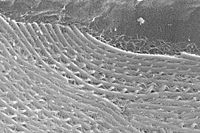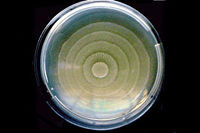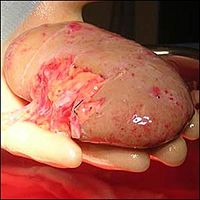Proteus mirabilis
| Proteus Mirabilis | ||||||||||||||
|---|---|---|---|---|---|---|---|---|---|---|---|---|---|---|
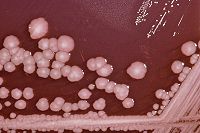 | ||||||||||||||
| Scientific classification | ||||||||||||||
| ||||||||||||||
| Binomial name | ||||||||||||||
| Proteus mirabilis |
Proteus mirabilis is a Gram-negative, rod-shaped bacteria belonging to the enterobacteriaceae family.[1] It is facultatively anaerobic meaning that it does not require oxygen for survival and reproduction and may even die in the presence of oxygen. Proteus mirabilis are found free-living in moist habitats, such as [water] and soil. They are also found in putrid meat, infusions, and abscesses.[2] They are mostly inhabitants of urinary tracts of human where they cause infections that are related with formation of renal and bladder calculi, also known as bladder stones.
Genome structure
Similarly to other Gram-negative bacteria, Proteus mirabilis contains an extracytoplamic outer membrane. In addition, the outer membrane contains a lipid bilayer, lipoproteins, polysaccharides, and lipopolysaccharides.[3] Various components of the membrane interplay with the host to determine virulence. Proteus mirabilis possesses flagella which play an important role in the bacteria's swarming motility and pathogenicty.[4]
The genome of Proteus mirabilis is .063 Mb long and has a G+C content of 38.88%. There is a single plasmid consisting of 36,289 nucleotides. Annotation of the genome is identified 3,685 coding sequences and seven rRNA loci. Analysis of the sequence confirmed the presence of previously identified virulence determinants, as well as a contiguous 54-kb flagellar regulon and 17 types of fimbriae. Genes encoding a potential type III secretion system were identified on a low-G+C-content genomic island containing 24 intact genes that appear to encode all components necessary to assemble a type III secretion system needle complex. In addition, the P. mirabilis HI4320 genome possesses four tandem copies of the zapE metalloprotease gene, genes encoding six putative autotransporters, an extension of the atf fimbrial operon to six genes, including an mrpJ homolog, and genes encoding at least five iron uptake mechanisms, two potential type IV secretion systems, and 16 two-component regulators.[5].
Cell structure and metabolism
Proteus can display two different morphological and physiological forms; one is known as the swimmer cells and the other as swarmer cells. In aqueous suspension Proteus mirabilis is found in the swimmer state, which is a small rod-like cells1 to 2 μm in length. They contain 8 to 10 flagella that aid in their swimming motility. On contact with a surface, Proteus mirabilis changes to the swarmer state where the cell considerably increases in length to form highly flagellated filaments that are 20 to 80 μm in length. These cells line up in parallel to form rafts that are able to move rapidly over surfaces en masse. On semi-solid surfaces such as an agar surface, they form concentric rings of growth. This pattern is caused by the coordinated burst of swarming activity interspeded with a consolidation to the swimmer state.[6]
An important feature of Proteus mirabilis is their swarming motility, which is a rapid and coordinated translocation of a bacterial population across solid or semi-solid surfaces.[7]. This ability aids them in food acquisition, reproduction and growth. It also aids the bacteria in expressing its virulence factors and invading hosts’ urothelial cells. They have the ability to produce urease, which is an enzyme that hydrolyzes urea to ammonia. In fact, Proteus mirabilis utilizes urea and citrate.[8]. It is therefore trivial for them to live in highly alkalinated environments. The bacterium also produces hydrogen sulfide gas, which aid in forming clear films on growth media, which can be distinguished as growth or concentric rings.[9].
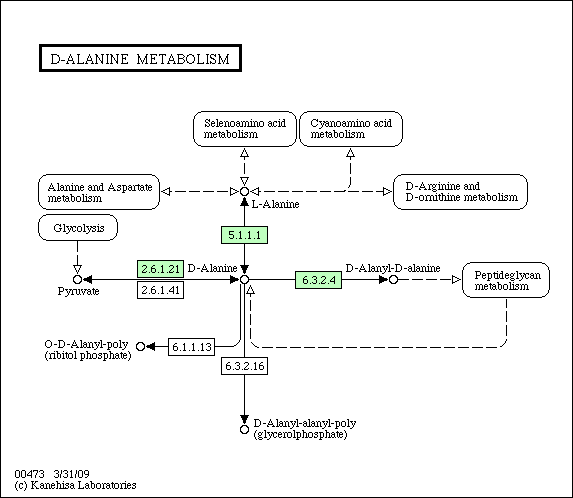
Ecology
Proteus mirabilis are found free-living in moist habitats, such as water and soil. They are also found in putrid meat, infusions, and abscesses. They are mostly inhabitants of urinary tracts of human where it is believed to cause urinary tract infections associated with formation of renal and bladder calculi, often known as bladder stones. Proteus mirabilis require an environment that has high alkalinity, meaning that the concentration of alkali in the solution, which is measured in terms of pH, must be high. A suitable environment for Proteus mirabilis must have a pH higher than 7.[10].
Pathology
Proteus mirabilis is a significant pathogen of the urinary tract. Urinary tract infection is a process following certain steps; it first starts with colonization of the bladder, which causes cystitis. Then, the infection proceeds to the kidneys, which leads to acute pyelonephritis, chronic inflammation and at last renal failure, which if left untreated, can cause death.[11].
Proteus mirabilis is highly virulent and contains many characteristics that aid in its pathogenicity. It possesses a flagella which is necessary for motility and is involved in causing infections. It also produces urease, which is responsible for the formation of bladder and kidney stones as a result of the hydrolysis of urea to ammonia. Furthermore, the haemolysin that the bacterium secretes is cytotoxic for urinary tract epithelial cells which are subject to invasion by the proteus.[12] The bacterium swarming motility also plays an important role in renal infections, which involve colonization of the lower urinary tract, followed by ascending movement of the bacterium. It is believed that the swarming motility is correlated with the effective invasion of hosts’ epithelia cells, as it provide the ability to move rapidly and therefore to rapidly colonize and invade the cells.
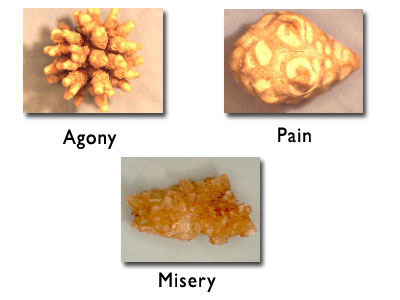
Application to Biotechnology
Current Research
Proteus mirabilis will give up its genetic secrets at ASM meeting
Scientists have conducted studies and now have explicit information to use in the fight against Proteus mirabilis. Data from the first complete genome sequence for Proteus mirabilis, which includes at least 3,693 genes and 4.063 megabases of DNA, will be presented at the 106th general meeting of the American Society of Microbiology taking place in Orlando from May 21-25. Melanie M. Pearson, Ph.D., a research fellow in microbiology and immunology at the University of Michigan Medical School, is the first scientist to perform an in-depth analysis of the genome sequence. Her research will allow other scientists to determine the virulence factors produced by the organism and learn how it causes disease. Pearson says. "Part of our goal is finding potential targets for new vaccines that could protect people from infection." In cases where stones form, the bacteria can become resistant to antibiotics," says Harry L.T. Mobley, Ph.D., professor and chair of microbiology and immunology in the U-M Medical School. Mobley is an expert on urease. Pearson's study explains why the bacterium has the ability to stick to some surfaces such as those of kidney or bladder stones. "This bacterium has an unusually high number of genes that encode for 15 different adherence factors or fimbriae on its surface," Pearson explains. "All these different fimbriae help the bacterium stick to bladder cells, catheters, kidney stones or each other.
Pearson also discovered that the Proteus mirabilis genome is made up of 24 genes that encode components of a system used to inject bacterial proteins into host cells. In future research, Pearson will use gene micro arrays to identify the Proteus mirabilis genes that are turned on, or expressed, during the infection stage. Genes involved in the infection process will be prime targets for future vaccine development, according to Pearson, although she says that years of additional research will be needed before vaccines could be commercially available.[13]
Inhibition of virulence factor expression and swarming differentiation of Proteus mirabilis by p-nitrophenylglycerol
It is found that PNPG could prevent Proteus mirabilis from growing and moving rapidly. according to a journal, PNPG inhibits the growth rate and swarming differentiation and activities of Proteus mirabilis. PNPG also inhabits the production of virulence factors such as urease, protease and haemolysin. It was found that in the presence of PNPG, the invasion hosts' epithelial cells diminuated dramatically. This is due to the fact that PNPG contains certains agents that impair the proper function of Proteus mirabilis. further studies are conducted in identifying those agents and applying them in medecine designed to fight proteus infections[14]
Reference
- ↑ http://emedicine.medscape.com/article/226434-overview
- ↑ http://www.wrongdiagnosis.com/medical/proteus_mirabilis.htm
- ↑ http://emedicine.medscape.com/article/226434-overview
- ↑ http://jmm.sgmjournals.org/cgi/reprint/49/8/725.pdf
- ↑ http://www.ncbi.nlm.nih.gov/pubmed/18375554
- ↑ http://www.biomedhtc.org.uk/ProteusMirabilis.htm#Top
- ↑ http://en.wikipedia.org/wiki/Swarming_motility
- ↑ http://en.wikipedia.org/wiki/Proteus_mirabilis
- ↑ http://www.biomedhtc.org.uk/ProteusMirabilis.htm#Top
- ↑ http://emedicine.medscape.com/article/226434-overview
- ↑ http://jmm.sgmjournals.org/cgi/reprint/49/8/725.pdf
- ↑ http://jmm.sgmjournals.org/cgi/reprint/49/8/725.pdf
- ↑ http://www.medicalnewstoday.com/articles/43969.php
- ↑ http://jmm.sgmjournals.org/cgi/reprint/49/8/725.pdf
